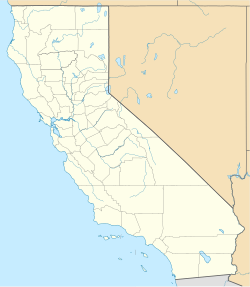Campo de Cahuenga
Campo de Cahuenga | |
California Historical Landmark No. 151 | |
 Campo de Cahuenga | |
| Location | 3919 Lankershim Blvd. Studio City, California 91604 |
|---|---|
| Coordinates | 34°8′24″N 118°21′42″W / 34.14000°N 118.36167°W |
| Built | 1847 |
| Architect | Landon and Spencer |
| Architectural style | Mission Revival-Spanish Colonial Revival |
| NRHP reference No. | 72001602 |
| CHISL No. | 151 |
| LAHCM No. | 29 |
| Significant dates | |
| Added to NRHP | December 19, 2003[2] |
| Designated LAHCM | 13 November 1964[1] |
The Campo de Cahuenga, (/kəˈwɛŋɡə/ ) near the historic Cahuenga Pass in present-day Los Angeles, was an adobe ranch house on the Rancho Cahuenga where the Treaty of Cahuenga was signed between Lieutenant Colonel John C. Frémont and General Andrés Pico in 1847, ending hostilities in California between Mexico and the United States. The subsequent Treaty of Guadalupe Hidalgo of 1848, ceding California, parts of Colorado, Nevada, New Mexico, and Arizona (but not Texas since it had seceded from Mexico in 1836, declared itself a republic, and joined the union in 1845) to the United States, formally ended the Mexican–American War. From 1858 to 1861 the Campo de Cahuenga became a Butterfield Stage Station.




History
[edit]The original adobe structure was demolished in 1900. The city of Los Angeles provided funds for the purchase of the property in 1923, and a Mission Revival and Spanish Colonial Revival style replica "adobe" ranch house was built by the city following an effort led by Irene T. Lindsay, then president of the San Fernando Valley Historical Society, and dedicated on November 2, 1950. It is now a park and interpretive center managed by the City of Los Angeles's Department of Recreation and Parks in partnership with the Campo de Cahuenga Historical Memorial Association. Campo de Cahuenga is registered on the National Register of Historic Places, as California Historical Landmark No. 151, and as Los Angeles Historic-Cultural Monument No. 29.
The foundations of the original adobe were unearthed beneath Lankershim Boulevard during construction of the Metro B Line subway. The parts of the foundations within the park are preserved as an exhibit, and the "footprint" of the foundations under the street and sidewalk is marked by decorative pavement.
Campo de Cahuenga is often confused with the nearby Rancho Cahuenga, an inholding within the Rancho Providencia land grant, now part of Burbank.
The building is used by various organizations for special programs and regular meetings, and it is open with a docent on the first Saturday of each month, from 12:00 PM to 4:00 PM.
California Historical Landmark
[edit]California Historical Landmark Marker No. 151 at the site reads:[3]
- NO. 151 CAMPO DE CAHUENGA - 'Here was made the Treaty of Cahuenga by General Andrés Pico, commanding forces for Mexico, and Lieutenant-Colonel J. C. Frémont, U.S. Army, for the United States. By this treaty, agreed upon January 13th, 1847, the United States acquired California - finally secured to us by the treaty of Guadalupe Hidalgo, made February 2nd, 1848.' This legend was written February 9, 1898 by Mrs. Jessie Benton Frémont.
See also
[edit]- Battle of Cahuenga Pass – 1831
- Battle of Providencia – 1845 Second Battle of Cahuenga Pass
- Conquest of California – 1846 Alta California
- Category:Conquest of California – 1846–1848
- Cahuenga, California; Tongva settlement.
- Tongva—Tongva language
- History of California through 1899
- History of the San Fernando Valley to 1915
- List of Los Angeles Historic-Cultural Monuments in the San Fernando Valley – city
- List of Registered Historic Places in Los Angeles – state
- Category: National Register of Historic Places in the San Fernando Valley – federal
References
[edit]- ^ Los Angeles Department of City Planning (September 7, 2007). "Historic - Cultural Monuments (HCM) Listing: City Declared Monuments" (PDF). City of Los Angeles. Archived from the original (PDF) on July 25, 2011. Retrieved May 28, 2008.
- ^ "National Register Information System". National Register of Historic Places. National Park Service. April 15, 2008.
- ^ californiahistoricallandmarks.com 151 Campo de Cahuenga
- Jorgenson, Lawrence C.: The San Fernando Valley Past and Present, Pacific Rim Research, Los Angeles, 1982 ISBN 0-941014-00-2
External links
[edit]- Los Angeles Department of Parks and Recreation – Campo de Cahuenga
- Campo de Cahuenga at the University of Southern California Archives
- Campo de Cahuenga Historical Memorial Association
- "Campo de Cahuenga - California Historical Landmark no. 151". library.ucsd.edu. 1936–1940. Retrieved December 31, 2023.
- Conquest of California
- History of the San Fernando Valley
- Houses on the National Register of Historic Places in Los Angeles
- Parks in Los Angeles County, California
- Museums in Los Angeles
- Historic house museums in California
- California Historical Landmarks
- National Register of Historic Places in the San Fernando Valley
- Los Angeles Historic-Cultural Monuments
- Mission Revival architecture in California
- Spanish Colonial Revival architecture in California
- Tongva populated places
- Studio City, Los Angeles
- Butterfield Overland Mail in California
- 19th century in Los Angeles
- 1847 establishments in Alta California
- Stagecoach stops in the United States




